![]()


![[Iridescent Pottery (0809)]](http://www.katrich.com/0809a.jpg)
![[Iridescent Pottery (0809)]](http://www.katrich.com/0809b.jpg)
![[Iridescent Pottery (0809)]](http://www.katrich.com/0809d.jpg)
![[Paul J. Katrich and Luster Vessel 0678]](http://www.katrich.com/pk678.jpg)
![[Iridescent Pottery (Four Seasons grouping)]](http://www.katrich.com/g_season.jpg)
![[YWCA Invitation for Spring Benefit 2004]](http://www.katrich.com/ks_inv.jpg)
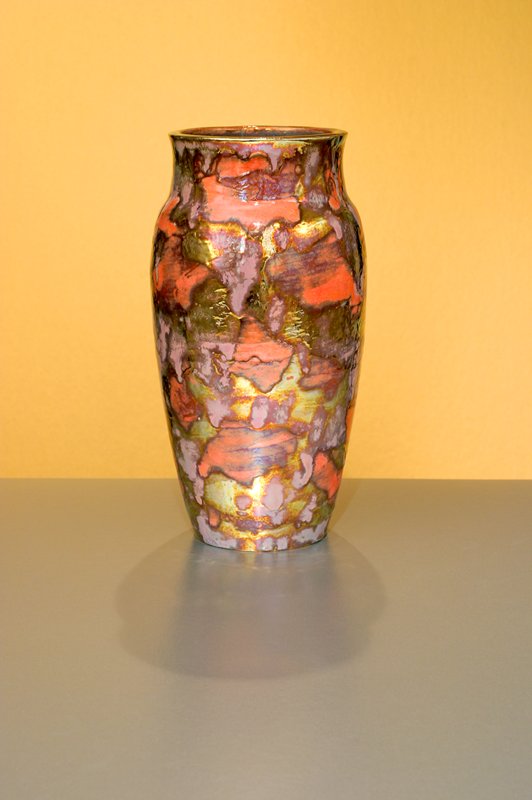
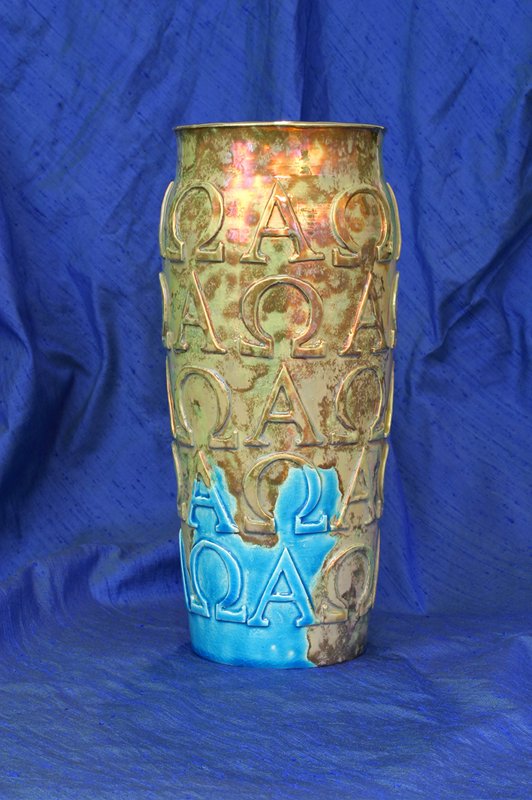
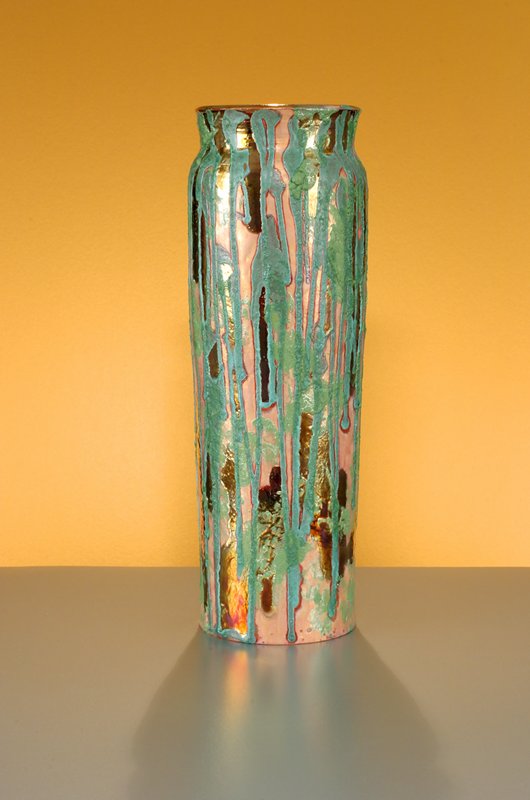
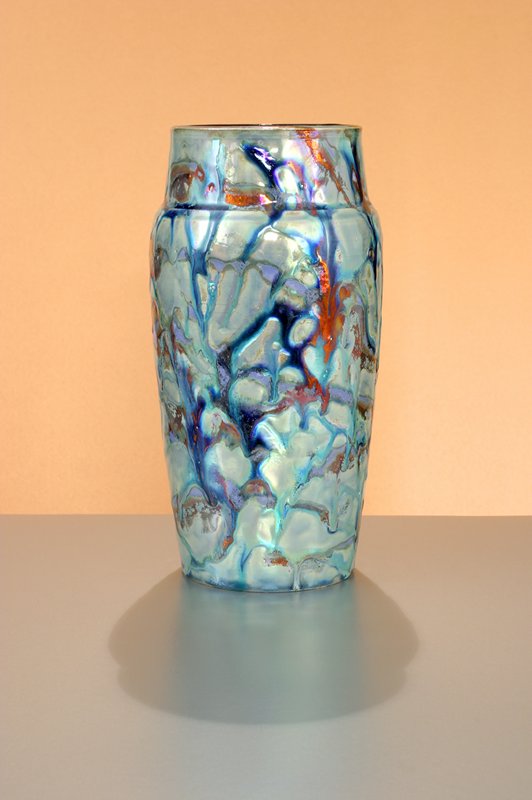
![[NY Ceramics Fair - National Academy Museum]](http://www.katrich.com/namuseum.jpg)
![[Katrich at NY Ceramics Fair, 2004]](http://www.katrich.com/ny_ceram.jpg)
![[Style: 1900 article in 2003]](http://www.katrich.com/s1900_sm.jpg)
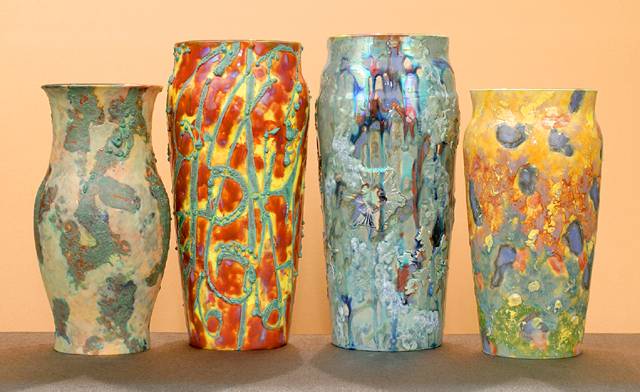
"Summer - August Dawn" (804),
"Autumn - When the Leaves Fall" (815),
"Winter - The First Snowfall" (810),
"Spring - The Winds Of April" (816),
|
An Interview with Paul J. Katrich by George A. Lees Q. How did you become a potter? A. I actually started out with the intention of being a painter. I didn't much enjoy painting classes, but the required Art History college courses intrigued me. I decided to do something related, which might offer the chance of making a living - Art Historian or Curator.
I have always loved art, and even had my own "museum" when I was a child (coins, stamps, seashells, etc.). Museum conservation was a career choice I happened into; one which seemed to offer an acceptable compromise. Q. What influence did conservation/restoration have in directing you towards pottery? A. Through good fortune, I found myself working in the conservation studio at a local museum, where I learned a tremendous amount. We had very limited resources, and had to be highly creative to make things work. We restored everything from railway cars to grandfather clocks. I had the wonderful experience of learning from the skilled hands of several older gentlemen, who were among the last and best in their trades. With some left turns, and additional degrees, this job ultimately led me to start my own restoration business. I eventually began to specialize in the repair and conservation of antique ceramics. Q. Why ceramics, in particular? A. I had enjoyed antique ceramics and glass for a long time, collecting them myself in a modest way. There was a real need in my area for a skilled restorer - I had no real competition. I was actually sort of crushed by success, because I always had too much business and not enough help, once I became known. Q. Why did you give up restoration? A. I didn't plan to - it's an unusual business. People don't realize that as a restorer you pretty much have to accept whatever work comes your way. If you are going to spend months restoring a piece - living with it intimately, you had better hope it's something you can stand the sight of. A good conservator has to almost immerse his personality in the object he is working on: to become another artist and leave himself behind.
I restored some fascinating objects: 18th century Meissen figurines, American Arts & Crafts vessels, ancient pottery, marble statuary, among others. Frequently, I'd have to teach myself an entirely new technique, or buy equipment just to work on a single piece. In the course of this experimentation, I kept finding myself called back to my own art. I had an affinity for ceramics that I never had for painting. I decided to use my accumulated wealth of unusual skills and equipment, and see if something new could issue from my own hands. Q. So then you were a success in pottery, overnight? A. Any artist who is looking for an instant reward isn't very realistic. I have a very healthy ego, which has taken quite a beating. Persistence is almost more important than talent.
I made a brief foray into tile manufacture. I found all my time consumed with employees, bookkeeping and people wanting me to match glazes to their sofa cushions. It was obvious that this couldn't be the kind of fine art that I needed it to be. My energies were not being properly used. Q. How did you begin to make lusterware? A. I had been aware of iridescent glassware, such as Tiffany, Loetz and Steuben, for many years. Later, I saw fine antique ceramic pieces from the Art Nouveau, Art Deco and Modernist Movements, which astonished me.
I have never taken a pottery course nor had a teacher. With books, research, endless patience and frustration, I taught myself to throw vessels and compound glazes. With naievete' and the aforementioned healthy ego, I set out to learn about luster making. Darned if I didn't do it, because no one told me I couldn't. Q. How do you view your work? A. I'm like an actor who sticks to a classical repertoire, or maybe an opera singer. I'm an unrepentant classicist. Frankly, I didn't like much of what I saw in the contemporary ceramics scene, and felt there was no welcome for me there. The Bernard Leach school caused a whole generation of potters to fear color. The emphasis on large expressionist sculptural work struck few chords with me.
I want color back, I want beauty back, and I don't think that elegance is a bad word. I don't claim to have invented lusterware. Neither am I the only one to utilize it. I want to do things with it that have never been done -- through the constraint of well-crafted objects, pleasing to the eye, and refreshing to the spirit. Q. What makes lusters special? A. I don't confine my work to lusters. I like brilliant color generally, but lusters contain an evocation of alchemy, which really appeals, and which I can't let go. Many of the past ceramists have gotten the addiction; it's like gold fever. Part of the attraction is the difficulty and expense of the process; the endless trouble to achieve a fine piece, and the satisfaction when you are able. Q. Which potters do you admire? A. There are many. I love much anonymous work from ancient cultures: Egypt, Persia, Cyprus and Greece. Of course, the luster compulsion has moved a number of gifted potters: Beatrice Wood, Maija Grotell, Clement Massier, Gertrude and Otto Natzler, Jacques Sicard, and the Zsolnay Factory.
I really identify with an obscure potter from the turn of the century, named Theophilus Brouwer. He was a self-taught innovator, who made incredible and beautiful luster vessels. His work is very rare, and I have never seen a piece that wasn't exceptional.
Glassmakers are also very important to me. Louis Tiffany was, in my opinion, the greatest decorative artist since the Renaissance. The Art Nouveau Movement was a season of giants, producing many extraordinary talents. That Tiffany and Emile Gallé were alive and working simultaneously is comparable to the age of Da Vinci and Michelangelo. They were that good. A contemporary artist, whose work I find particularly exciting and beautiful, is glassmaker Dale Chihuly. Q. Where is your work heading? A. I want to explore colors in nature, to the farthest degree possible. I have never understood potters who insist on variations of brown as bringing them closer to the earth. The natural world is riotous with color -- organic and inorganic. I recognize no limits in this regard. Most of all, I intend to create beautiful, meaningful objects that bring joy to the possessor, in the same proportion as they did in the making. This is not a hobby or affectation: this is my profession. There is much left to do. |